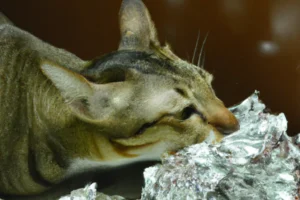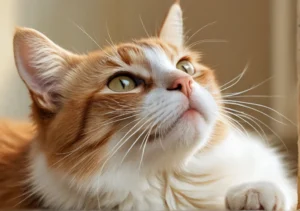Cats are known for their quirky behaviors, and one common quirk is their fear of tin foil. But have you ever stopped to wonder why? Let’s delve into the reasons behind this strange feline phobia.
Sensitivity to Sound
Cats are known for their incredibly sharp hearing, which is far superior to that of humans. This heightened sense of hearing allows them to detect even the faintest of sounds, which can be both a blessing and a curse. When it comes to crinkling tin foil, the noise produced is not only loud but also high-pitched, causing discomfort to our feline friends. Imagine nails on a chalkboard, but for cats!
The crinkling sound of tin foil can be magnified in a cat’s ears, making it an unpleasant and even painful experience for them. This sensitivity to sound explains why cats may run and hide at the mere sight or sound of tin foil. It’s like turning the volume up to max on a song you can’t stand – definitely not a pleasant experience!
Reflective Nature
Have you ever noticed how cats can be captivated by their own reflection in a mirror? It’s like they’ve stumbled upon a mysterious twin they can’t quite figure out. Now, imagine encountering that twin in a shiny, reflective surface like tin foil. The sight of their reflection in such a strange context can be incredibly unsettling for cats.
Cats are naturally cautious and curious creatures, so when they see their reflection unexpectedly while encountering tin foil, it can trigger their fight-or-flight response. The sudden appearance of what seems like a stranger cat can evoke fear and anxiety in our pets, leading them to avoid tin foil at all costs. It’s like stumbling upon a doppelgänger in a dark alley – definitely not a situation you want to linger in!
Texture Aversion
Cats have sensitive paws, making the crinkly texture of tin foil unpleasant for them. This unique texture can be unsettling to cats, causing them to avoid or fear it. The noise and feel of walking on tin foil can be particularly off-putting for our feline friends. To help your cat feel more comfortable, provide soft and cozy alternatives for them to walk on, such as rugs or blankets.
Association with Negative Experiences
Past negative experiences or punishments involving tin foil can contribute to a cat’s fear of it. If a cat has had a frightening encounter with tin foil in the past, they may develop a fear or aversion to it. To help your cat overcome this fear, create positive associations with tin foil by offering treats or playing with them near it in a calm and reassuring manner.
Instinctual Response
Cats have a strong instinctual response to unfamiliar objects, including tin foil. Their survival mechanisms kick in when they encounter something new or out of the ordinary. The crinkly sound and shiny texture of tin foil can trigger a cat’s natural fear of the unknown, as they associate it with potential danger. This reaction is deeply rooted in their instincts to be cautious and avoid potential threats in their environment.
Alternative Materials
Instead of using tin foil to deter unwanted behaviors in cats, consider alternative materials that are effective without causing fear. Citrus scents, such as orange or lemon, are known to repel cats due to their strong odor. You can use citrus-scented sprays or diffusers in areas where you want to discourage your cat from going. Another option is double-sided tape, which has a sticky texture that cats dislike walking on. Place the tape on surfaces you want to protect, like furniture or countertops, to deter your cat from scratching or jumping on them. Additionally, providing your cat with appropriate scratching posts and toys can help redirect their behavior in a positive way.
- Citrus scents (orange or lemon) – Repels cats due to strong odor.
- Double-sided tape – Sticky texture that cats dislike walking on.
- Provide appropriate scratching posts and toys – Redirects behavior positively.
By using alternative materials that are safe and effective, you can encourage positive behaviors in your cat without causing unnecessary fear or stress.
Trivia: Cat Behavior
Did you know that cats have a natural aversion to certain textures and sounds? This can explain why cats may be afraid of tin foil. The crinkling noise and the smooth, slippery surface of tin foil can be unsettling for our feline friends, triggering their instinctual response to avoid potential sources of danger. Understanding this behavior can help us better empathize with our cats and find ways to make them feel more comfortable in their environment.
Tips for Cat Owners
Gradual Exposure : If your cat is scared of tin foil, try gradually introducing it into their environment. Start by placing a small piece of tin foil in a room where your cat frequently spends time. Allow them to approach and investigate it at their own pace. Over time, they may become desensitized to the material.
Provide Alternatives : Some cats may be fearful of tin foil due to the noise it makes when touched. You can offer your cat alternative scratching surfaces or toys to redirect their attention away from the tin foil. This can help alleviate their anxiety and prevent unwanted behavior.
Create Safe Spaces : Cats thrive in environments where they feel safe and secure. If your cat is particularly sensitive to tin foil, consider designating certain areas of your home as “tin foil-free zones.” This can give your cat a sense of control and reduce their stress levels.
Consult a Professional : If your cat’s fear of tin foil is causing significant distress or interfering with their quality of life, it may be beneficial to seek advice from a veterinarian or animal behaviorist. They can provide personalized guidance on how to address your cat’s specific needs and fears.
By taking the time to understand your cat’s behavior and preferences, you can help them overcome their fear of tin foil and create a harmonious living environment for both of you.
Alex, a passionate animal lover, has experience in training and understanding animal behavior. As a proud pet parent to two dogs and three cats, he founded AnimalReport.net to share insights from animal experts and expand his knowledge of the animal kingdom.




